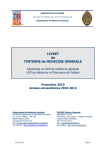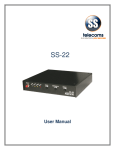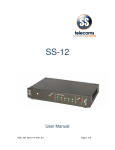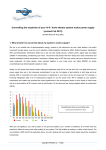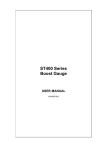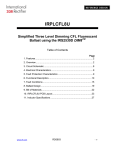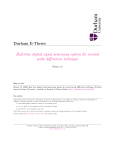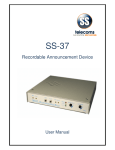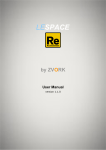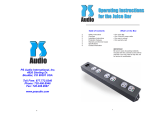Download Cabling Guide
Transcript
Unraveling the mysteries of cables and cable terminations So what is the fuss all about? It is a well-known fact that system cabling is probably the most underrated element of any hi-fi or home theatre system; albeit one that could potentially have a significant impact on the overall performance of your audio/video system. The well-known phrase: “A device is only as good (or reliable) as its weakest link”, is equally true when it comes to your audio/video system. After all, the cabling is the transport mechanism of all audio/video signals between components and between components and speakers – compromising this crucial function would surely compromise overall system performance. Cables, being the longest part of a system, act as efficient antennas, picking up or radiating electrical noise. A cable's ability to minimise unwanted noise and to accurately transfer the frequencies inherent in the audio spectrum (20Hz-20kHz) impact on the performance of your system. Your time and money spent in purchasing your dream system would be compromised if quality time had not been spent in evaluating suitable quality interconnect- and speaker cabling (and even power cabling). Equally, the performance of a quality cable would be compromised if its cable terminations are inferior or falls short from the design quality of the cable itself. Truly then, cables are a vital component in today's modern audio and visual systems and it is imperative that they are given the utmost consideration. What do the experts say? There are countless articles, debates, excerpts and cable vendor “claims” published over the years in various audio/video- and hi-fi magazines world-wide that offers a plausible (or confusing) explanation of the advantages (or disadvantages) of using different types of cable/conductor material and/or cable/conductor designs in a system. Most audiophiles believe that cables make a difference. However, most electronics engineers maintain that the effects that different cables may have on a system are restricted to small – really small – frequency response shifts, the kind of thing we probably cannot even hear; and if we can, doesn’t really matter. The cable debate would probably never come to an end…our advice to you? Trust your EARS! Don’t be fooled by sales talk (or prices). The only thing that really matters is that your system should sound better to you after fitting a specific brand of cable. If not, move on and try another brand. To abate some of the controversial issues of cables, Hi-Fi CHOICE (HFC, a well-respected British hi-fi magazine) has recently taken the plunge by publishing their technical discoveries on tests done in their labs, which sheds fascinating new light on wire. The article was published in their September 2005 edition (TECHNO Column). The tests done by HFC revealed the following facts: (1) High resistance speaker cabling can be shown (measured experimentally) to upset the frequency response of some speakers by a detectable amount. Or otherwise stated speaker cables can cause distortion. Yes, nonlinear, harmonic and intermodulation distortion, the sort of flaw normally attributed only to electronics and transducers. (2) High inductance cabling can also roll off treble very slightly; and high capacitance is known to upset some amps. The bottom line? Speaker cables with the lowest possible resistance and inductance over the audio band will sound superior! Even so, HFC acknowledges that they are still a long way from understanding why different quality interconnect cables sound differently and exactly why cables can affect the stereo imaging of a system; and even further from proving the superiority (or otherwise) of solid core wires, or cryogenically treated cables, or special insulated materials, to name a few. In what follows, we will provide an overview of the basic factors that determine the quality of a cable, as well as basic cable design concepts. The information is based on the cable design philosophy of Ecosse Reference cables. Ecosse Manufacturing Company (www.ecossecables.co.uk), based in Scotland UK, design and manufacture a wide range of high-quality, multi-award winning cabling for the audio/video industry, be it for entry level- or high-end systems. 1 Factors determining the quality of loudspeaker-, power- and interconnect cables TPC For starters, it is important to note that a cable is a passive component in any system and cannot add to the quality of the original signal; but only subtract from it or mask certain characteristics thereof. The ultimate goal of any cable manufacturer is to strive for cable designs that least subtract from (or distort) the original delicate audio (or video) signal. There are three main factors that determine the quality of cabling and hence their ability to accurately transport the original signal with as little as possible change in its original frequency characteristics, namely: 1. The purity of the conductor material How does the purity of conductor material affect a music signal? In short, the purer the conductor material, the less the music signal will be distorted from its original whilst traveling along the cable. As such, the higher the purity of conductor material the greater the “improvement” (less damage to original signal) would be, thus resulting in better system performance, enhanced resolution, clear bass, image height, depth and width. Ecosse offers vastly superior SuperMonocrystal™ and Monocrystal™ copper (and silver) and multi-award winning Ultra-High Purity Oxygen-Free Copper/Silver (UHP-OFC/S) as conductor materials in their cable designs. The sound of an UHP-OFC/S cable is smoother, cleaner, and more dynamic than the same design made with standard OFC. SHOCK: NOT ALL OFC’s ARE THE SAME! Ecosse's OFC has but 40 parts per million grains versus normal Copper, which has about 235 ppm grains. It is these grain boundaries which cause irritating distortions and have a deleterious effect on sound. The purification of their copper drastically reduces the formation of copper oxides, thereby substantially reducing the distortion caused by grain boundaries. OFC UHP-OFC Monocrystal Monocrystal™ pure copper material ensures an almost complete lack of 'grain-boundaries' in the signal transmission direction - impurities which would normally impede the delicate audio signals and result in attenuation and distortion. Here, a patented casting process (extrusion and annealing) is employed to produce a 'mono' or single crystal ultra-pure wire with significant advantages over other cables such as ordinary copper or silver, which, no matter how few grains the manufacturer claims, have a grain barrier of oxygen and hydrogen. The main technical parameters of Monocrystal™ are as follows: 1. Continuous casting Monocrystal copper rod's metallographic structure has less than 3 'grains'; each single grain occupies over 75% of the total area. 2. Compared with multi-crystal cast rod, the Monocrystal copper's tensile strength is increased by 10~20%, elongation rate is reduced by 50~80% and section shrinkage rate reduces by 200~300%. 3. Compared with the more common (Perfect Copper) Ohno continuous-cast copper (OCC or PCOCC) process, Ecosse’s continuous cast Monocrystal copper's conductivity has been increased by between 2~10%. 4. Oxygen content: less than 5ppm 5. Hydrogen content: less than 0.25ppm 6. Density: not less than 8.920g/cm 7. Average grain size: 125m (below 0.3mm) 8. Purity: Minimum 5N (99.999%) 3 2 N.B. Audiophiles please note that it is the purity of 'grain structure' (not to be confused with purity of copper or silver employed - often expressed as 99.99% or better - and merely signifying the purity of the copper ingot before melting), which defines the major characteristics in the conductor's ability to transmit audiophile quality sound and video. For the record, Monocrystal™ is a minimum 5N's pure; SuperMonocrystal™ 7N! 2. The quality of the insulation material The selection of insulation material and construction methods influences the accuracy of musical timbre and ambience. The dielectric constant of the insulation material influences the ability of the cable to deliver rhythmic, fast and uniform sound. Frequencies fluctuate according to the efficiency of the dielectric constant of the insulation employed and as such insulation materials of minimum dielectric loss are desirable in cable designs. COMPARISON CHART Dielectric Material Dielectric Constant Air 1 Foamed Polyethylene 1.5 to 2.1 Teflon 2.03 Polyethylene 2.27 to 2.5 Polypropylene 2.25 Nylon 4.0 to 4.6 PVC 3.8 to 8.0 A perfect dielectric will store zero energy and therefore, not take away any signal from the conductor. The closest to a perfect dielectric is air with a dielectric value of one, but it is not practical to use air as a dielectric as the entire assembly would have to be hermetically sealed. All dielectric materials absorb energy, a phenomenon called dielectric absorption. Dielectric absorption can degrade the signal so it’s important to use the best dielectric insulation for the task as the energy absorbed by the dielectric is released back into the cable slightly delayed in time – an undesirable condition. Interconnects and power cables should only employ the finest insulation materials of either low-density foamed Polyethylene or Teflon (PTFE); and should be double- and even triple shielded, thereby ensuring accuracy of musical timbre and ambience. Quality insulation will also reduce EMI, RFI and 'proximity effect'. Ecosse uses either polyethylene or even Teflon (PTFE - polytetrafluoride epoxy) dielectric as these insulators exhibit superior mechanical properties (such as isolation to vibration) to maximise the signal and its transmission velocity. Furthermore, air-foaming reduces the dielectric constant and the dielectric loss by introducing air, thereby stabilising the frequency characteristics of the cable. For loudspeaker cables, twisted pairs of multi-stranded or solid core conductors sheathed in polypropylene provides superior performance, as these two types most effectively reduce electrostatic capacitance, proximity effect (where the two conductors attract resulting in a greater resistance to the signal) and facilitates noise rejection (RFI). 3. The preciseness of the cable construction Ecosse believes that the most natural sound is achieved by a combination of low inductance and low resistance designs. Inductance particularly influences high frequencies. Low inductance minimises high end 'roll off' and low resistance ensures powerful bass and low midrange. (Note how this inherent philosophy of Ecosse, that was written well before the HFC magazine article mentioned previously, correlates with the recent experimental findings of the magazine). Resistance in the speaker circuit is probably the deciding factor in determining loudspeaker performance; and as such, all speaker cables must exhibit low resistance, which together with low inductance, ensures a smooth, musically accurate performance. For loudspeaker cable construction, Ecosse uses multistranded and perfectly circular solid core conductors. For superior performance of multi-stranded configurations, the delicate stranded conductors should be sheathed in lowdielectric polypropylene insulation and carefully bound in a concentric and tight lay, then twisted. Concentric lay stranded conductors involve multiple layers of wire laid out uniformly in a longitudinal direction with adjacent strands laid in opposite directions. These strands form a perfect circle, which stabilises the characteristic impedance through the length of the cable, resulting in superior sound quality. Rope-lay exploded 3 With 'rope-lay' construction, the wire should be pleated, thereby allowing a large cross-section of cable. This is vital as large cross-sections (2.00sq mm +) provide a low DC resistance for the transmission of low frequency (bass) information, (together with extended stereo width, height and depth) and a greater surface area for the transmission of high frequency signals. N.B. Above about 3.5sq mm, other factors become significant and the cable's ability to accurately transmit audio is compromised. Ecosse believes that solid core conductors are particularly effective at extending high frequencies – counteracting the deleterious consequences of 'skin-effect' whereby high frequency signals tend to occupy the periphery of the conductor due to their failure to enter the conductor centre. These frequencies do not use the entire section of the wire and consequently meet increased resistance. Polyethylene insulation - as this material exhibits least energy store loss. Yes, even better than Teflon! When it comes to digital interconnect cables, particular attention should be given to the conductor material, the dielectric used and the electrical properties it exhibits in terms of inductance, impedance, and rejection of the environment – e.g. EMI, RFI noise. It is of fundamental importance for the transmission of high frequency and pulse signals, such as those from a digital (or video source), that the transmitted signals match the characteristic impedance of the digital cable. The correct type of digital cable is an asymmetrical, or coaxial, typically of 75 Ohm impedance. If an alternative is used, then the signal will be reflected – 'jittered' – and the square wave signal form will be distorted, causing a roll off in high frequency information. And lastly, proper terminations! The occupational area for a high frequency signal is greater with a solid conductor, therefore resistance is reduced and delivery of high frequency information is improved. In Ecosse bi-wire cable designs, the solid core conductors are connected to the high-frequency (HF tweeter) cross-over (in contrast to what their competitors do) to sweeten the treble and increase the overall signal bandwidth; whilst multi-stranded conductors are used on the low-frequency (LF - woofer) cross-over. Using a biwiring configuration, the net effect is a reduction in impedance seen by the amplifier; load is reduced and frequency response increased. The upshot of which is a genuine extension of soundstage and dynamics. The construction of interconnect cables consists of either coaxial or 'balanced' conductors. Here, Ecosse employs a rope-lay multi stranded topology – insulated then twisted (to reject unwanted noise) and surrounded in a soft PVC sheath. The terminations at the ends of cables are part of the transmission path and vital to it. High quality terminations are essential to a quality cable. You need a large surface contact between the cable plug and the component's jack, and high contact pressure between them. Ecosse plug terminations are soldered to the conductor using Supersolder™, their zero-tin (tin is high in impurities which increase conductor resistance and galvanic corrosion), ultra-high conductivity solder. Terminations become oxidized over time and the connection can become 'bad' to the point where clearly audible distortion occurs. To reduce this concern, only gold or silver plated plugs should be used. Ecosse are the only company in the world offering noncompressing copper RCA plugs on their premier/premier+ analogue, digital and video interconnects, and grain-free Monocrystal™ plugs (RCA, XLR, Spade and Banana) on their more expensive audiophile/reference grade cables; thereby ensuring a unified, ultra-pure connection between sources and from source to loudspeaker. Interconnect cables are composed of three main elements: the signal conductors, the dielectric, and the terminations. The conductors carry the delicate audio signal; the dielectric is an insulating material between and around the conductors to reduce signal loss; and the terminations provide the proper connection to audio equipment. Ecosse uses (for the most) Foamed 4 Ecosse MACH2 RCA schematics: Conclusion Cables (and cable terminations) and the claims laid down on their importance in any audio/video system will always be a controversial and much debated subject. N.B. No interconnect plug should grip a cable with a collet or grub screw action - as this type of plug compresses the signal. Audiophiles should note that collet-action or grub screw plugs can sometimes compress the cable impedance as low as 25 Ohms, resulting in signal reflections, which can be disastrous. Even so, the factuals presented in this article should sway you, the reader, one way or the other….to either embrace the importance of good cabling and their role as a vital component in your system, or to discard what has been said. One way or the other, the fact that cabling is the longest component in your system and that all audio/video signals are being transported across them; and that they introduce distortion in your system, cannot be denied. Surely then cabling should deserve the same time and attention you would give in purchasing other individual system components, or else you may be compromising on the true potential of your system. The Idiot’s guide to proper handling of cables Cables are delicate scientifically designed products, so, for optimum performance: 1. Do not wind, bundle, stretch or tightly bend. 2. Do not place the audio cable in parallel with a power cable. 3. Do not place the audio cable in parallel with ferrous constructions. 4. Do not leave one end of any cable open, and do not allow positive and negative paths to short circuit. 5. Disconnect unnecessary cables. 6. Do not try and affect a join in cables. 7. Periodically clean any oxidation from contacts. 8. Do not use in unnecessarily long lengths. 9. Keep all power cords away from interconnects, speaker wire, video cables and all other wire from the equipment; all the way to the wall-outlet or line conditioner. If you absolutely have to cross a power cord then do so at a 90-degree angle. 10. Cables should be installed in a relaxed position. Never kink or try to make a short cable reach; there should be gentle bends at both ends for optimal stress relief for the attached components and cabling. 11. Always insert or remove a cable by gripping the plug – not the cables. This technical article was prepared by AVCables CC. They may be contacted on 082 774 4831 or visit their website at www.avcables.co.za. All rights reserved. Jeandr e Botha Digitally signed by Jeandre Botha DN: cn=Jeandre Botha, o=AVCables cc, ou, [email protected], c=ZA Date: 2008.11.19 08:07:18 +02'00' 5





